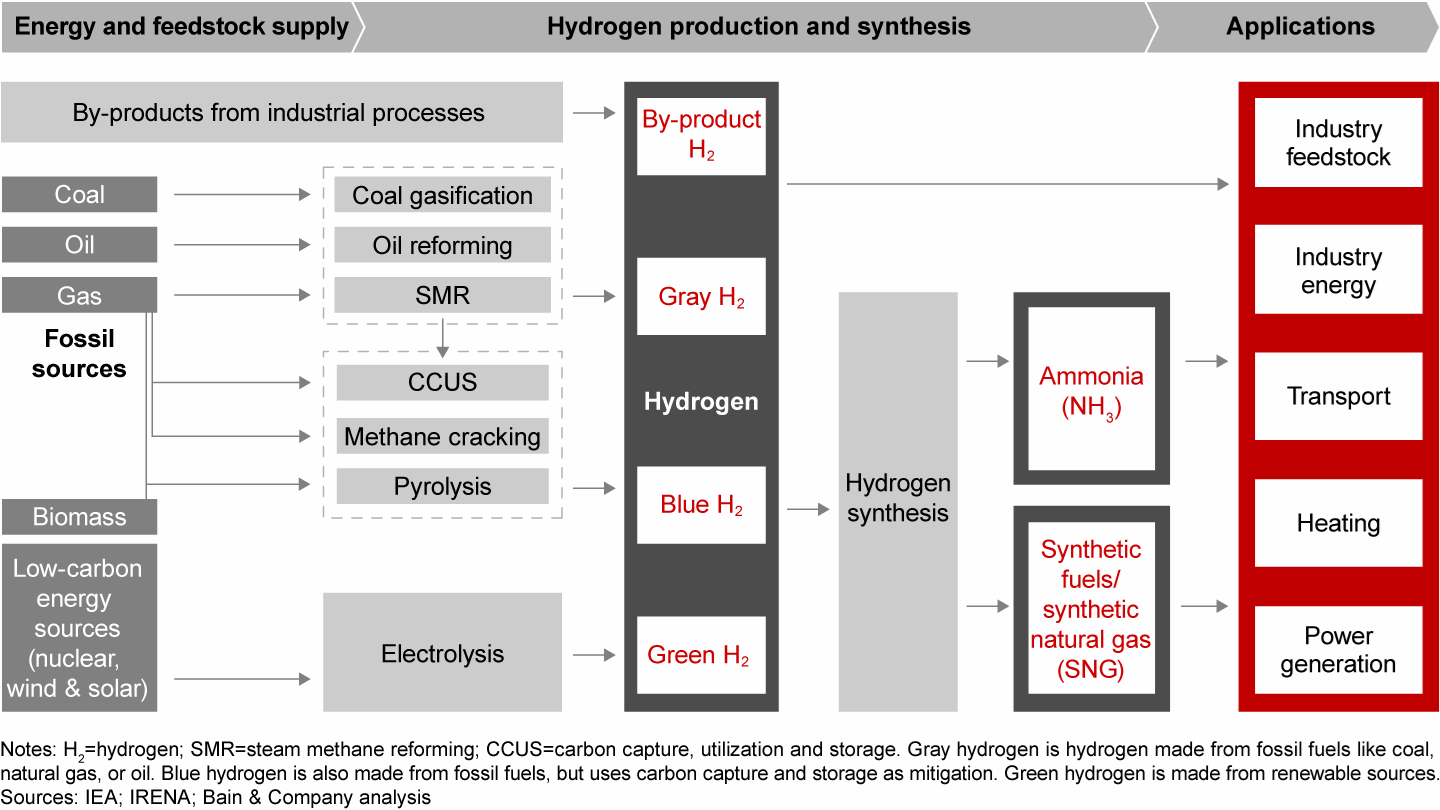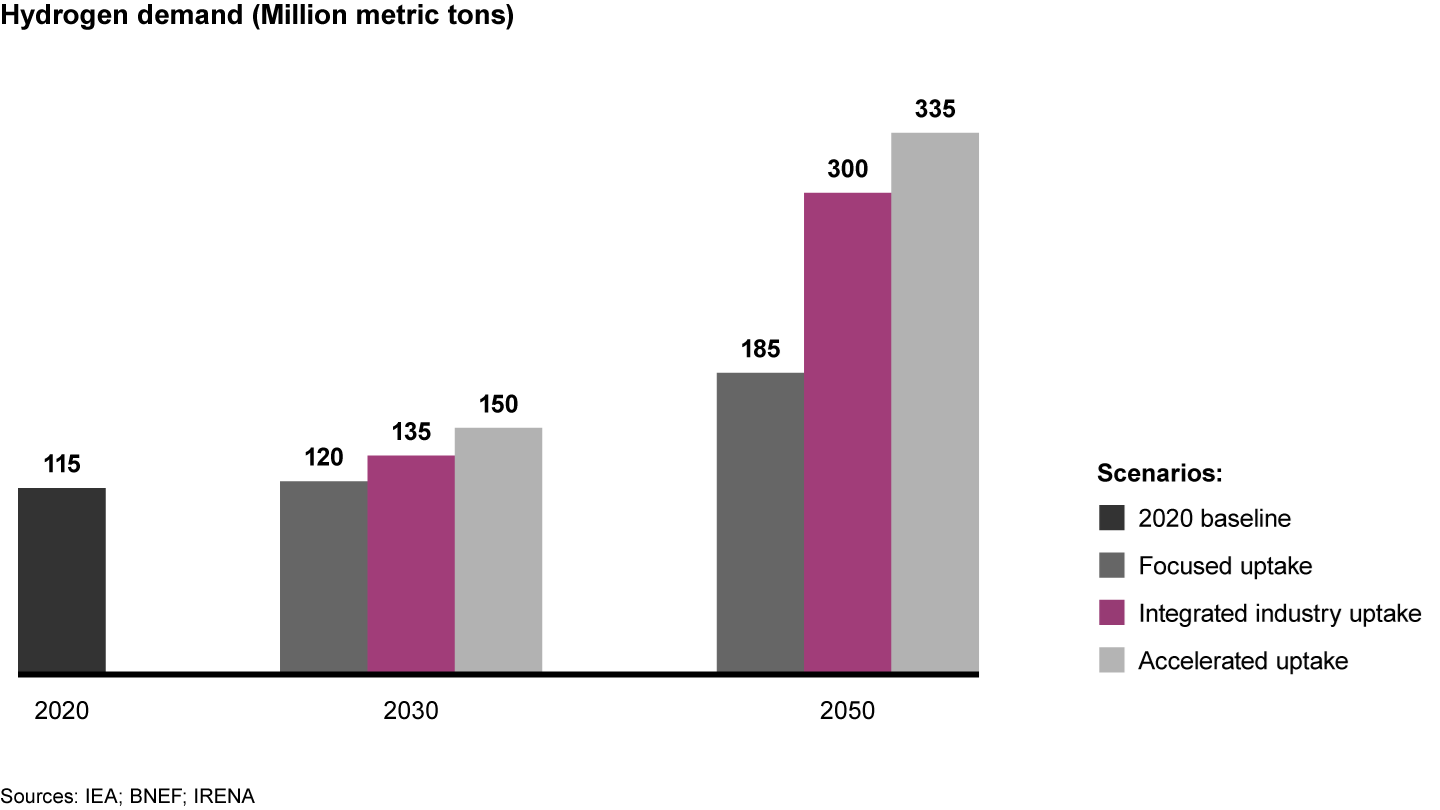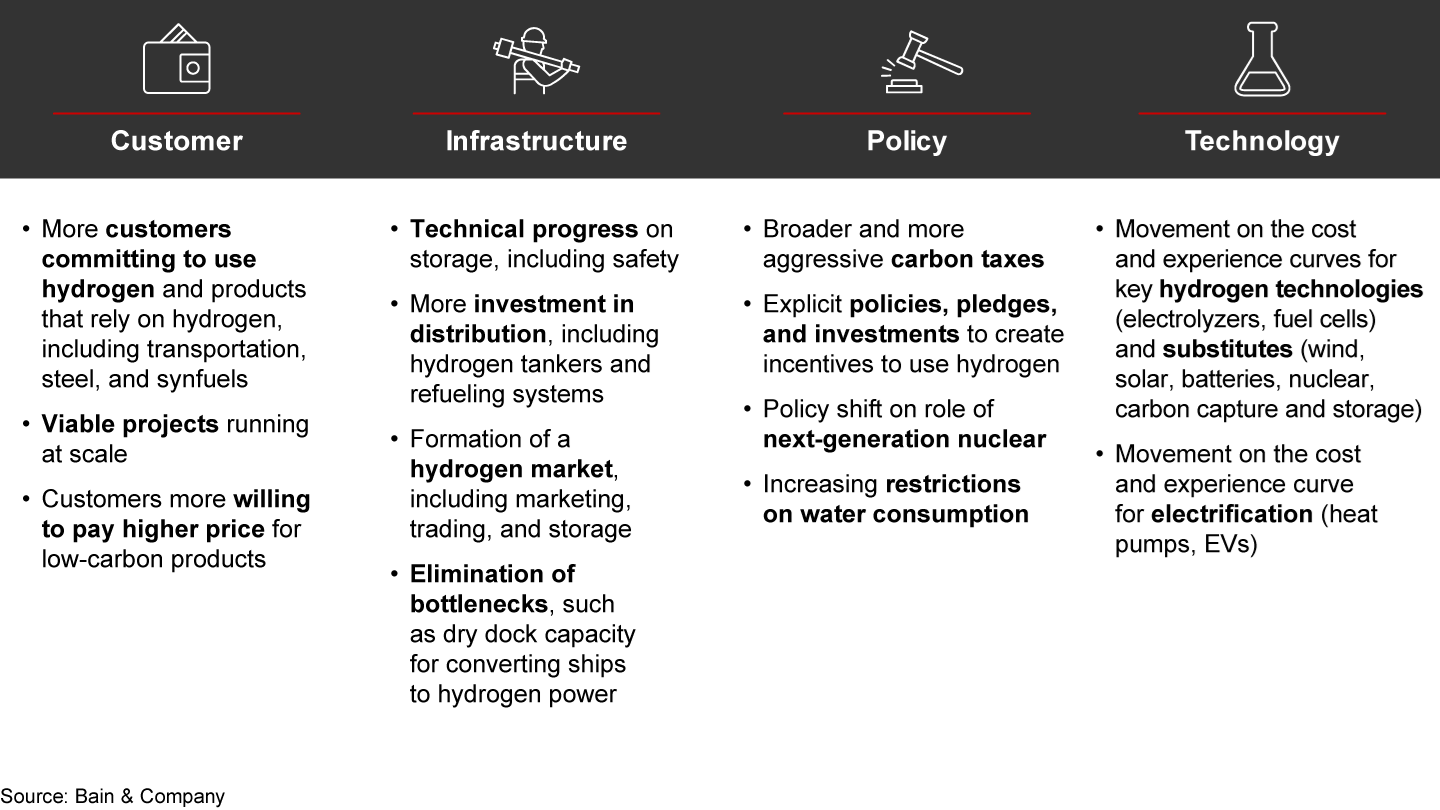Brief

Executive Summary
- Hydrogen is emerging as a viable, low-carbon energy source for some industrial and transportation uses.
- Depending on incentives and uptake, the demand for hydrogen could nearly triple by 2050.
- Hydrogen producers, infrastructure players, and customers should be looking at where hydrogen is likely to play a role in their business and work back to understand the value chain and its linkages. Most will need to build new capabilities to take best advantage of the opportunity.
This isn’t the first time hydrogen has been promoted as an energy solution for the future: Some will remember that when oil prices spiked in the 1970s and early 2000s, hydrogen’s star appeared to rise. As oil prices stabilized and economies moved on, hydrogen was left with its primary role as an industrial feedstock.
This time looks to be very different given the global push to decarbonize and the role hydrogen could play to drive down emissions across many industries and end-use applications, many that would otherwise be hard to decarbonize (see Figure 1). Hydrogen’s energy density, potential role in energy storage, and ability to enable low or zero-carbon applications in industry and transportation all point to hydrogen becoming an integral part of the energy mix. The International Energy Agency reports that more than 20 new hydrogen projects have been announced for commissioning in this decade. Indeed, hydrogen is already cost competitive in some applications in certain geographies, and it is difficult to see how some otherwise hard-to-decarbonize parts of industry can thrive without it.
Hydrogen can be used pure or to produce other energy carriers like ammonia and synthetic fuels, and is especially relevant in applications that would be otherwise hard to decarbonize


But hydrogen’s path is not straightforward, with its growth trajectory and profit pools yet to be determined. Opportunities and timing will vary across regions and industries, depending on offtake potential, supply conditions, and infrastructure requirements. Customer demand will be as or more important than supply availability.
Even so, the most plausible scenarios point to the emergence of an attractive market, so it would be a strategic misstep for companies to take a backseat position. Across industries, executives should be looking at the potential applications for hydrogen and working back through the value chain to determine which are most feasible—and where to place their bets. To give executives a better view of the possibilities, Bain analyzed the potential market and identified five no-regrets actions to take in order to position your company for success in the hydrogen market of the future.
Hydrogen market scenarios
Bain researched several scenarios for the growth of the hydrogen market, taking into consideration the full range of potential future applications, hydrogen’s ability to play a meaningful role against zero-emission alternatives, based on whether hydrogen is the right solution, as well as factors such as cost competitiveness, and the readiness of technology and supply to meet demand. As renewable energy becomes more cost competitive, green hydrogen will become less expensive to produce. Supporting technologies, such as carbon capture and electrolyzers, will become less expensive as they are built out. Increases in carbon prices and taxation will further improve hydrogen’s competitiveness, and government subsidies will act as a catalyst to accelerate learning and cost decline.
Our base case scenario, an integrated industry, points toward a global market of 300 million metric tons (Mtons) by 2050 with the potential to establish a profit pool of more than $250 billion (see Figure 2). This would represent an initial period of modest growth from 2020 to 2030, with demand accelerating after that.
Three scenarios, based on speed of adoption, deliver vastly different markets by 2050


In this scenario, we assume most major industries will increase their use of hydrogen, some more than others. For example, in transportation we expect battery electric vehicles to become the standard for most vehicle categories, and hydrogen to play a role in specific vehicle classes like heavy-duty trucks, or for specific applications where hydrogen has an advantage over alternatives—for example, where batteries would be too heavy. In this scenario, we assume transportation and industrial applications will make up 80% of the demand, with power, heat, and other uses making up the rest. Since some of these high-potential applications will require significant investments in infrastructure (for example, hydrogen fuel stations for transportation) or process changeovers (such as replacing traditional blast furnaces to enable a direct reduced iron process in steel production), short-term opportunities may be found in other industrial or power applications.
We could also see an accelerated uptake scenario in which, for example, hydrogen plays a role as fuel for power production or energy storage for renewables, depending on the decarbonization plans of major power utilities. However, given the uncertainties in the uptake of technologies and relative competitiveness of hydrogen, adoption could be much slower, which would result in something closer to our focused uptake scenario with an estimate of 185 Mtons by 2050.
Both blue and green hydrogen (that is, hydrogen from low-carbon and zero-carbon sources) make up less than 1% of total hydrogen production today. Significant advances in technology and experience will have to occur to make these competitive, along with more renewable energy, infrastructure for the transport and storage of hydrogen, and a large installed base of industrial applications to nurture growth. Public investments will be required to create the right initial opportunities and catalyze market growth until hydrogen, blue or green, can be competitive at scale on its own.
Winning in the hydrogen value chain
All this may look very far away, and many companies have pressing priorities in 2021. Still, given the potential for hydrogen to play a meaningful role in the energy transition, companies should get started now to define how they will participate and take advantage of this massive opportunity. Here are five ways to get started.
Think future-back to understand hydrogen’s potential. For every participant in the market, the first step is understanding which applications across sectors have the greatest potential to adopt hydrogen, and recognizing the underlying drivers. This involves looking not only at costs, but also at competitive alternatives, sources of supply, enabling technologies and regulatory policy, both international, federal, and local.
Across applications, demand will be driven in two ways:
- In some cases, hydrogen could be the single best solution to reduce emissions, where customers are willing to pay for it—for example, blast furnace-based steelmaking or cement production. Adoption is predictable, but depends on the business case, ease of transitioning, and asset replacement schedules.
- In other cases, hydrogen will need to be cost competitive against other low- or zero-carbon solutions. Here, adoption speed will depend on factors like the availability of low-cost renewable energy to make green hydrogen and the availability of alternative supply chain infrastructure for hydrogen (see Figure 3).
Hydrogen could be cost competitive with some low-carbon substitutes by 2030
Long-term competitiveness needs to be based on market forces, but in the near term policymakers can help shape the development of the hydrogen economy by encouraging investment or direct funding that may allow hydrogen to move quicker along the experience curve.
The development of renewable power generation offers an analogy. Direct subsidies from federal governments (for example, wind and solar tax credits in the US) helped accelerate adoption of renewable technologies down a steep learning curve such that they are competitive today, without subsidies, with fossil generation in many markets around the world. The creation and maturation of the hydrogen market will require similar support, and we are already seeing budding examples in the European Union and specific European countries, including the UK, the Netherlands, Denmark, Germany, and Poland.
Choose your focus and participation model. As the hydrogen market’s value chain develops, so too will supply, production, and logistics chokepoints that influence the pace of adoption. To gain a sustainable competitive advantage, companies need to understand these chokepoints and how they influence the relative attractiveness of participation models.
Effective participation models start with strong positions that capitalize on existing capabilities and expertise, while setting a trajectory toward future profit pools. Lead times to positive cash flow can be long, so companies need to choose carefully and commit to staying the course as the market develops, avoiding the temptation to respond to business cycles and short-term priorities.
Industry partners will be important, not only to spread risk but also to share knowledge, avoid high learning costs, and build positions in adjacent fields. Some partnerships are already underway, and four main models are taking shape:
- Project consortia. Players across the value chain team up to accomplish specific projects. For example, a consortium of 10 private and public sector partners are collaborating on the North-C-Methanol project in Belgium. This project brings together a full range of expertise required to capitalize on the hydrogen opportunity and demonstrate how hydrogen can contribute to building a circular, more sustainable economy. The raw materials (water, renewable energy) are extracted locally while the finished products (green methanol) and derivative flows are all used locally (for example, by customers such as ArcelorMittal, Alco Bio Fuel, and Yara).
- Securing production and system integration. Engineering and construction firms, oil companies, and hydrogen companies invest in hydrogen production facilities and offer system integration services across the value chain.
- JVs and minority share investments. Suppliers and end users take minority shares or team up to offer production or other services at other key points of the value chain.
- New business expansion. Value chain players, including renewables developers, engineering firms, and logistics companies, move into adjacent businesses.
Define a robust yet flexible execution plan and monitor signposts. With a clear view of the potential for hydrogen applications in their industry, companies can begin to form an action plan with no-regrets moves and low-risk options for capital investment. As with any strategy under uncertainty, executives will want to monitor critical signposts to identify market changes early, allowing them to shift directions and make bets more confidently—all while balancing risk profiles and investment intensity with the expected longer-term rewards (see Figure 4). Given the uncertainties in the hydrogen market, strategic plans should remain flexible and resilient, with options to scale or pivot if signposts are triggered.
Leading players in the development of the global battery materials market adopted a similar strategy when they realized that growth in battery materials would be driven by automotive electrification. Robust market scenarios were tracked and linked to signposts such as specific battery technology and cost development, cell maker investments and focus, and automakers’ platform developments. These insights informed their investment decisions to create leading positions early on and pathways to sustained long-term profits.
Companies can track development of hydrogen markets by monitoring signposts


Choose the best opportunities and launch first projects. As with any developing market, hydrogen growth is likely to concentrate around clusters of demand and supply potential, and we expect to see several waves of opportunity.
Initial sweet spots are already emerging where existing hydrogen demand can be met with competitively priced supply. These can be areas with a supply of low-cost hydrogen (as in Chile, the Middle East, and Australia) or areas where alternatives are expensive (for example, steel production in remote areas in Scandinavia), or where government incentives compensate for incremental cost, as in industrial clusters in Belgium, Germany, and the Netherlands.
For longer term opportunities, companies can adopt a test-and-learn approach, leveraging early sweet spots to gain a head start. These opportunities will center around applications where hydrogen helps meet decarbonization ambitions (as with most industrial applications), or where hydrogen uptake may be most significant despite uncertainties (for example, specific niches of heavy-duty, fuel-cell vehicles). LNG markets developed in a similar way over the past decade, as producers sought out low-cost supply and built up shipping, export facilities, and other necessary infrastructure to deliver to known pockets of demand.
Where hydrogen costs are competitive, adoption is likely to occur more quickly, allowing those players to develop deep experience with their applications, and possibly to prepare their capabilities and infrastructure for broader markets. Governments will play an important role as catalysts, stimulating demand through emissions rules and pushing down costs with investments and incentives.
Define the right operating model to align hydrogen within business priorities. New initiatives often struggle to find their place within existing operating models, particularly when these new opportunities threaten to cannibalize the current business or promise to upend traditional processes. In some companies, hydrogen efforts will be extensions of the core business, while for others they will represent second engines of growth (for more, see the Bain Brief “The Engine 2 Imperative: New Business Innovation and Profitable Growth under Turbulence”). Depending on the strategy, participation model, and distance from the core business, hydrogen may need support to ensure its progress. Three areas of focus can help ensure hydrogen’s place in the organization’s business priorities.
- Ownership and accountability. Decide who manages the long-term hydrogen roadmap, including collaboration with external partners, and helping the organization monitor the critical signposts and associated decisions—for example, new minimum viable projects and targeted M&A.
- Long-term investment. Ensure sufficient and sustainable funding to mobilize around the opportunity, nurture hydrogen’s progress, and avoid becoming contingent on other business priorities with shorter payoff. This is more about mobilization than traditional deployment of capital.
- Relationship to core. Determine how the hydrogen effort will work with the rest of the company to ensure its success, including tapping talent and capabilities, mobilizing rapidly, and scaling to achieve efficiencies.
Start today
While the path of the hydrogen market is uncertain, it’s uncertain for everyone alike. Companies can begin to build and extend a strategic advantage in hydrogen by developing a greater understanding of market factors and the underlying constraints and opportunities of their specific place in the hydrogen value chain. Leaders will train their focus on the customer and avoid getting distracted by technology. Collaborations with key partners, selective M&A activity, and subsidized pilot projects can help companies build market position as prices decline.
The five imperatives outlined here shouldn’t be approached sequentially: Executives should move on all five to speed their progress along the experience curve and gain a stronger competitive position. As with any strategy under uncertainty, they should move ahead with optionality and continue to adjust as some opportunities lose their luster and as others present themselves.